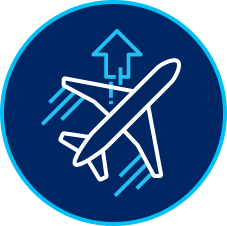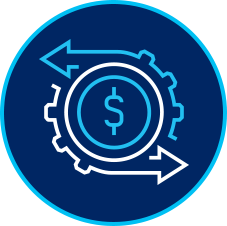The GTAA tracks and measures key sustainability indicators to help manage performance and drive continuous improvement.
We have developed a downloadable Sustainability Management Approach and GRI Index, which includes the management approach, metrics and performance data included in our online annual report, as well as GRI data and additional content in accordance with the GRI Standards: Comprehensive option (self-declared). Our GRI reporting includes the Airport Operators Sector Disclosure, which the GTAA helped to develop in 2011.
We continue to use an internal verification program to review Toronto Pearson’s performance data – including, but not limited to, assessing how data was captured, collected, reviewed and reported. We evaluated a sample of information related to the performance indicators to confirm that a documented process and adequate controls are in place; this ensures our ability to present consistent and accurate data. The GTAA does not currently have a policy or mandate with respect to externally assuring our non-financial reporting.

Our Priorities
Due to the evolving nature of the global aviation industry, the GTAA has committed to reviewing our priority (material) topics every five years. However, we address specific stakeholder priorities and concerns on an ongoing basis. We will next review our priority topics by 2020.
In our 2015 Annual Report, we undertook a thorough review of priority topics by reassessing those identified in the previous year’s report. To determine priority reporting topics, we considered stakeholder feedback gathered through surveys and other methods, as outlined in the Stakeholder Engagement section of this report.
We also looked at our priorities from an internal perspective – for example, how they aligned with the goals outlined in our strategic framework, and with leadership insights shared during annual in-person interviews conducted with members of the GTAA’s executive team.
Our Priority Topics
The diagram below provides a present-day view of our corporate responsibility priorities. They are tied to our
 Safety
Safety
- Lost-time injuries (LTI) reduction
- Promoting a culture of safety and security
- Safety and security management systems
- Toronto Pearson Safety Index Program
 Passenger and Customer Service
Passenger and Customer Service
- Airport Service Quality (ASQ)
- Efficient passenger flow per ICAO standards
- Service Level Agreements and performance standards with major airline partners
- Ground transportation
 Corporate Responsibility – Social
Corporate Responsibility – Social
- Economic impact and opportunities
- Community engagement
- Noise management
 Corporate Responsibility – Environmental
Corporate Responsibility – Environmental
- Energy
- Climate-change adaptation
- Greenhouse gas emissions
- Waste and stormwater management
- Deicing and anti-icing fluid
 Aviation Growth
Aviation Growth
- Airport capacity
- Long-term partnerships
- Public policy and compliance
 Financial Sustainability
Financial Sustainability
- Net income
- Return on assets
- Free cash flow generation
- Business continuity
 Engaged People
Engaged People
- Employee engagement
- Talent acquisition
- Talent development
- Rewards and recognition
Performance Scorecard
| Goals and Performance Metrics | 2016 | 2017 | Projected | |||||||||||||||||||||||||||||
|---|---|---|---|---|---|---|---|---|---|---|---|---|---|---|---|---|---|---|---|---|---|---|---|---|---|---|---|---|---|---|---|---|
|
||||||||||||||||||||||||||||||||
|
||||||||||||||||||||||||||||||||
|
||||||||||||||||||||||||||||||||
|
||||||||||||||||||||||||||||||||
|
||||||||||||||||||||||||||||||||
|
||||||||||||||||||||||||||||||||
- 102-35
- 102-38
- 102-47
Learn more about how we operate our airport responsibly
At Toronto Pearson, we embrace our obligation to manage growth sustainably. We respect the needs of all stakeholders while balancing the vital dimensions of social, economic and environmental responsibility.
